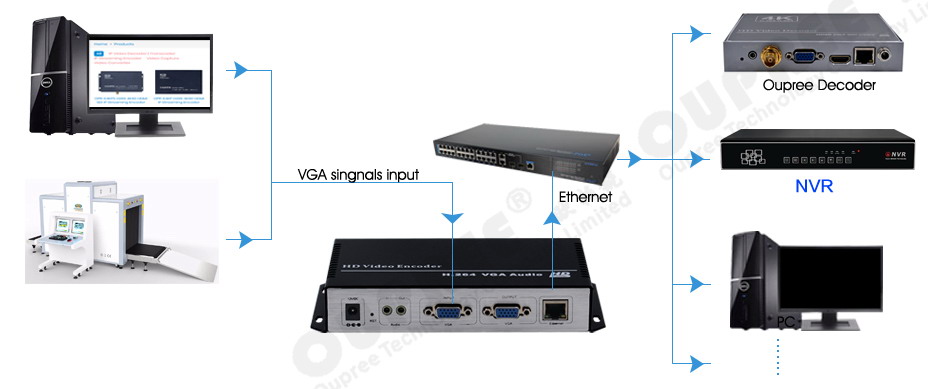VGA Encoder for Security Surveillance
VGA encoders are instrumental in security applications, especially when it comes to converting VGA signals into network-based video streams for remote monitoring and management. Here's a detailed look at how VGA encoders integrate with NVRs (Network Video Recorders) for unified security management:
1. VGA Encoder Integration with NVR for Security Surveillance
Application Scenario:
- Centralized Monitoring: VGA encoders convert VGA output from various security devices, such as PCs or industrial control panels, into IP streams. These streams can then be integrated with an NVR system for centralized monitoring and recording. This setup is beneficial for environments like control centers, traffic management systems, and industrial facilities where multiple VGA sources need to be monitored from a central location.
Process:
- VGA signals from sources like security cameras or computer screens are fed into the VGA encoder.
- The encoder compresses and converts the VGA signal into a network-friendly format, typically using codecs like H.264 or H.265 for efficient video streaming.
- The encoded video stream is then transmitted over the network to the NVR.
- The NVR acts as the central hub, receiving video streams from multiple VGA encoders and managing the storage, retrieval, and playback of these streams.
Advantages:
- Scalability: Adding more cameras or encoders is straightforward, allowing the system to scale as needed without significant infrastructure changes.
- Remote Access: NVRs can be accessed remotely, enabling security personnel to monitor VGA streams from different locations.
- Efficient Storage Management: NVRs provide centralized storage management, making it easier to organize and retrieve recorded footage.
2. Technical Considerations for VGA to NVR Integration
Encoder Selection:
- Choose VGA encoders that support the required resolutions and compression standards compatible with the NVR system.
- Consider the network capabilities of the encoders to ensure smooth stream transmission without latency issues.
NVR Configuration:
- Ensure the NVR has enough input channels to accommodate the number of VGA encoders.
- Configure the NVR to recognize and manage the video streams from VGA encoders, including setting up user access and stream quality.
Network Infrastructure:
- The network should be robust enough to handle the bandwidth required for simultaneous video streams from multiple VGA encoders.
- Use switches and routers that can prioritize video traffic to prevent network congestion.
3. Practical Applications
Case Study:
- In a large industrial facility, VGA encoders are used to stream real-time footage from production line control panels to a central security hub.
- The NVR system receives these streams and allows security personnel to monitor operations and respond to any incidents promptly.
- The system also records all streams for quality control and safety compliance.
Challenges and Solutions:
- Bandwidth Limitations: High-resolution VGA streams can consume significant bandwidth. Solution: Use H.265 encoding for better compression without sacrificing image quality.
- System Compatibility: Ensuring all components work well together. Solution: Choose encoders and NVRs that are tested and certified for compatibility.
4. Future-Proofing the System
As technology evolves, consider the following to future-proof the VGA to NVR integration:
- Upgrade Path: Ensure that both the encoders and NVRs can be upgraded to support new features and higher resolutions.
- Adaptability: The system should be adaptable to new codecs or changes in network protocols.
- Integration with Other Systems: Plan for potential integration with access control systems, alarm systems, and other security measures for a comprehensive security solution.
In conclusion, VGA encoders paired with NVRs offer a powerful solution for security applications, providing a reliable and efficient way to manage and monitor VGA video streams across various environments. Proper planning, selecting the right encoders, and ongoing system maintenance are key to leveraging this technology for optimal security surveillance.






